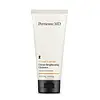What's inside
What's inside
 Key Ingredients
Key Ingredients

No key ingredients
 Benefits
Benefits

 Concerns
Concerns

 Ingredients Side-by-side
Ingredients Side-by-side

Water
Skin ConditioningSodium Laureth Sulfate
CleansingCocamidopropyl Betaine
CleansingDecyl Glucoside
CleansingPPG-2 Hydroxyethyl Coco/Isostearamide
Sodium Chloride
MaskingDimethyl Mea
BufferingAscorbyl Palmitate
AntioxidantSodium Benzoate
MaskingEthylhexylglycerin
Skin ConditioningMagnesium Aspartate
Skin ConditioningZinc Gluconate
Skin ConditioningCopper Gluconate
Skin ConditioningDisodium EDTA
Citric Acid
BufferingTetrasodium EDTA
Phenoxyethanol
PreservativeParfum
MaskingWater, Sodium Laureth Sulfate, Cocamidopropyl Betaine, Decyl Glucoside, PPG-2 Hydroxyethyl Coco/Isostearamide, Sodium Chloride, Dimethyl Mea, Ascorbyl Palmitate, Sodium Benzoate, Ethylhexylglycerin, Magnesium Aspartate, Zinc Gluconate, Copper Gluconate, Disodium EDTA, Citric Acid, Tetrasodium EDTA, Phenoxyethanol, Parfum
Water
Skin ConditioningSodium Cocoyl Isethionate
CleansingGlycerin
HumectantCoco-Glucoside
CleansingCocos Nucifera Oil
MaskingStearic Acid
CleansingCocamidopropyl Betaine
CleansingGlyceryl Stearate Se
EmulsifyingPhenoxyethanol
PreservativeXanthan Gum
EmulsifyingOpuntia Vulgaris Extract
Skin ConditioningCocos Nucifera Fruit Juice
EmollientSodium Chloride
MaskingGlyceryl Polyacrylate
Trisodium Ethylenediamine Disuccinate
Water, Sodium Cocoyl Isethionate, Glycerin, Coco-Glucoside, Cocos Nucifera Oil, Stearic Acid, Cocamidopropyl Betaine, Glyceryl Stearate Se, Phenoxyethanol, Xanthan Gum, Opuntia Vulgaris Extract, Cocos Nucifera Fruit Juice, Sodium Chloride, Glyceryl Polyacrylate, Trisodium Ethylenediamine Disuccinate
Ingredients Explained
These ingredients are found in both products.
Ingredients higher up in an ingredient list are typically present in a larger amount.
Cocamidopropyl Betaine is a fatty acid created by mixing similar compounds in coconut oil and dimethylaminopropylamine, a compound with two amino groups.
This ingredient is a surfactant and cleanser. It helps gather the dirt, pollutants, and other impurities in your skin to be washed away. It also helps thicken a product and make the texture more creamy.
Being created from coconut oil means Cocamidopropyl Betaine is hydrating for the skin.
While Cocamidopropyl Betaine was believed to be an allergen, a study from 2012 disproved this. It found two compounds in unpure Cocamidopropyl Betaine to be the irritants: aminoamide and 3-dimethylaminopropylamine. High-grade and pure Cocamidopropyl Betaine did not induce allergic reactions during this study.
Learn more about Cocamidopropyl BetainePhenoxyethanol is a preservative that has germicide, antimicrobial, and aromatic properties. Studies show that phenoxyethanol can prevent microbial growth. By itself, it has a scent that is similar to that of a rose.
It's often used in formulations along with Caprylyl Glycol to preserve the shelf life of products.
Chances are, you eat sodium chloride every day. Sodium Chloride is also known as table salt.
This ingredient has many purposes in skincare: thickener, emulsifier, and exfoliator.
You'll most likely find this ingredient in cleansers where it is used to create a gel-like texture. As an emulsifier, it also prevents ingredients from separating.
There is much debate on whether this ingredient is comedogenic. The short answer - comedogenic ratings don't tell the whole story. Learn more about comegodenic ratings here.
The concensus about this ingredient causing acne seems to be divided. Research is needed to understand if this ingredient does cause acne.
Scrubs may use salt as the primary exfoliating ingredient.
Learn more about Sodium ChlorideWater. It's the most common cosmetic ingredient of all. You'll usually see it at the top of ingredient lists, meaning that it makes up the largest part of the product.
So why is it so popular? Water most often acts as a solvent - this means that it helps dissolve other ingredients into the formulation.
You'll also recognize water as that liquid we all need to stay alive. If you see this, drink a glass of water. Stay hydrated!
Learn more about Water